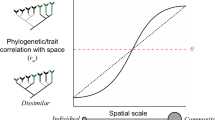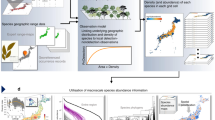Abstract
We have recently proposed to use partial canonical ordinations to partition the variation of species abundance data into four additive components: environmental at a local scale, the spatial component of the environmental influence, pure spatial, and an undetermined fraction. By means of an example, we show how to use the information contained in these fractions to provide better insight into the data. In particular, the interpretation is assisted by separately mapping the various canonical axes and relating them to possible generating processes. We derive a general framework for the causal interpretation of the various fractions of this partition, which includes the environmental and the biotic control models, as well as historical dynamics.
Similar content being viewed by others
References
Birks, H.J.B., Juggins, S. and Line, J.M. (1990). Lake surface-water chemistry reconstructions from palaeolimnological data. In: The Surface Waters Acidification Programme (B.J.Mason), Cambridge University Press, pp. 301–13.
Borcard, D. (1986). Une sonde et un extracteur destines a la récolte d'Acariens (Acari) dans les sphaignes (Sphagnum spp.).Bull. Soc. Entomol. Suisse,59, 283–8.
Borcard, D. (1988). Les Acariens Oribates des sphaignes de quelques tourbieres du Haut-Jura suisse. PhD Thesis, Université de Neuchâtel, Switzerland.
Borcard, D. (1991). Les Oribates des tourbieres du Jura suisse (Acari, Oribatei): écologie. 11. Les relations Oribates — environnement a la lumière du test de Mantel.Rev. d'Écol. Biol. Sol,28, 323–39.
Borcard, D., Legendre, P. and Drapeau, P. (1992). Partialling out the spatial component of ecological variation.Ecology,73, 1045–55.
Bray, R.J. and Curtis, J.T. (1957). An ordination of the upland forest communities of southern Wisconsin.Ecol. Monographs,27, 325–49.
Cancela da Fonseca, J.P. and Poinsot-Balaguer, N. (1983). Les regimes alimentaires des Microarthropodes du sol en relation avec la decomposition de la matière organique.Bull. Soc. Zool. France,108, 371–88.
Garay, I. and Nataf, L. (1982). Microarthropods as indicators of human trampling in sub-urban forests. In:Urban Ecology (R. Bornkamm, J.A. Lee and M.R.D. Seaward, eds) Blackwell, Oxford. pp. 201–207.
Harper, P.-P. and Cloutier, L. (1985). Composition et phénologie de commuautés d'insectes du lac Geai, lac dystrophe des Laurentides (Quebec).Natur. Canadien (Revue d'Écol. System.),112, 405–15.
Hutchinson, G.E. (l957). Concluding remarks. Cold Spring Harbor Symp.Quant. Biol.,22, 415–27.
Isaaks, E.H. and Srivastava, R.M. (1989).Applied Geostatistics. Oxford University Press, New York.
Lebrun, P., van Impe, G., de Saint Georges-Gridelet, D., Wauthy G. and André, H.M. (1991). The life strategies of mites. In:The Acari. Reproduction, Development and Life-history Strategies (R. Schuster and P.W. Murphy, eds) Chapman & Hall, London.
Leduc, A., Drapeau, P., Bergeron, Y. and Legendre, P. (1992). Study of spatial components of forest cover using partial Mantel tests and path analysis.J. Veg. Sci.,3, 69–78.
Legendre, P. and Fortin, M.-J. (1989). Spatial pattern and ecological analysis.Vegetatio,80, 107–38.
Legendre, P. and Troussellier, M. (l988). Aquatic heterotrophic bacteria: modeling in the presence of spatial autocorrelation.Limnol. Oceanogr.,33, 1055–67.
Legendre, P., Troussellier, M., Jarry, V. and Fortin, M.-J. (1989). Design for simultaneous sampling of ecological variables: from concepts to numerical solutions.Oikos,55, 30–42.
Legendre, P. and Troussellier, M. (1993). Origin of spatial structures in aquatic bacterial communities: From hypotheses to numerical solutions. In:Trends in Microbial Ecology (R. Guerrero and C. Pedrós-Alió, eds) Proceedings of the Sixth International Symposium on Microbial Ecology (ISME-6), Barcelona, 6–11 September 1992. pp. 353–8
Lindeman, R.L. (1942). The trophic-dynamic aspect of ecology.Ecology,23, 399–418.
Mantel, N. (1967). The detection of disease clustering and a generalized regression approach. Cancer Res.,27, 209–20.
Matthey, W. (1965). Signification de la butte a sphaignes dans l'évolution de la haute tourbière. Comptes Rendus Soc. Biogéog.,371-2, 119–30.
May, R.M. (1984). An overview: real and apparent patterns in community structure. In:Ecological Communities: Conceptual Issues and the Evidence (D.R. Strong Jr, D. Simberloff, L.G. Abele and A.B. Thistle, eds) Princeton University Press. pp. 3–16.
Plinski, M. and Magnin, E. (1979). Analyse écologique du phytoplancton de trois lacs des Laurentides (Quebec, Canada).Canadian J. Bot.,57, 2791–9.
Quinn, J.F. and Dunham, A.E. (1983). On hypothesis testing in ecology and evolution.Am. Naturalist,122, 602–17.
Siepel, H. (1989). Objective selection of indicator species for nature management. Comptes-rendus du Symposium ‘Invertébrés de Belgique', pp. 415–18.
Smouse, P.E., Long, J.C. and Sokal, R.R. (1986). Multiple regression and correlation extensions of the Mantel test of matrix correspondence.System. Zool. 35, 627–32.
Southwood, T.R.E. (l987). The concept and nature of the community. In:Organization of Communities: Past and Present (J.H.R. Gee and P.S. Giller, eds) Blackwell Scientific Publications, Oxford. pp. 3–27.
Stevenson, A.C., Birks, H.J.B., Flower, R.J. and Battarbee, R.W. (l989). Diatom-based pH reconstruction of lake acidification using canonical correspondence analysis.Ambio,18, 228–33.
ter Braak, C.J.F. (1986). Canonical correspondence analysis: a new eigenvector technique for multivariate direct gradient analysis.Ecology,67, 1167–79.
ter Braak, C.J.F. (1987a). The analysis of vegetation-environment relationships by canonical correspondence analysis.Vegetatio,69, 69–77.
ter Braak, C.J.F. (1987b). Ordination. In:Data Analysis in Community and Landscape Ecology (R.H.G. Jongman, C.J.F. ter Braak and O.F.R. van Tongeren, eds) PUDOC, Wageningen. pp. 91–173.
ter Braak, C.J.F. (1988a). Partial canonical correspondence analysis. In:Classification and Related Methods of Data Analysis (H.H. Block, ed.) North Holland Press, Amsterdam. pp. 551–8.
ter Braak, C.J.F. (1988b). CANOCO — an extension of DECORANA to analyze species-environment relationships.Vegetatio,75, 159–60.
ter Braak, C.J.F. (1990). Update notes: CANOCO version 3.10. Agricultural Mathematics Group, Wageningen, The Netherlands.
Vannier, G. (1985). Mode d'exploitation et de partage des ressources alimentaires dans le système saphrophage par les microarthropodes du sol.Bull. d'Êcol.,16, 19–34.
Wauthy, G., Noti, M.-I. and Dufrêne, M. (1989). Geographic ecology of soil oribatid mites in deciduous forests.Pedobiologia,33, 399–416.
West, C.C. (1984). Micro-arthropod and plant species associations in two subantarctic terrestrial communities.Oikos,42, 66–73.
Wiens, J.A. (1984). On understanding a non-equilibrium world: Myth and reality in community patterns and processes. In:Ecological Communities: Conceptual Issues and the Evidence (D.R. Strong Jr, D. Simberlofl; L.G. Abele and A.B. Thistle, eds) Princeton University Press. pp. 439–57.
Whittaker, R.H. (1956). Vegetation of the Great Smoky Mountains.Ecol. Monographs,26, 1–80.
Author information
Authors and Affiliations
Additional information
Daniel Borcard is research associate in animal ecology at Universite de Neuchâtel, Switzerland. He is interested in soil ecology, and presently working on fundamental and applied projects dealing with peat bog ecology and protection, community succession dynamics, as well as effects of agriculture on mite and insect communities. In order to develop the statistical tools necessary for these projects, he also works in collaboration with Pierre Legendre on modeling the spatial structure of ecological communities. $Pierre Legendre is professor of quantitative biology at Universite de Montreal. He is a former Killam Research Fellow (1989–91), and a member of the Royal Society of Canada since 1992. He is the author of some 100 refereed articles, over 250 papers presented at scientific meetings and research seminars, dealing with numerical ecology, community ecology, environmental assessment and spatial analysis, and textbooks (in French and English) on numerical ecology. During the past 5 years, he served as the Secretary-Treasurer of the International Federation of Classification Societies. *We thank Dr V.M. Behan-Pelletier, of Agriculture Canada, for her help in the identification of the Oribatid mites, and Mrs Lucie Fortin and Dr P. Neumann, Universite de Montreal, for their identifications of the Sphagnum species. This research was carried out during tenure of a Postdoctoral Fellowship of the Swiss National Foundation for Scientific Research by D. Borcard, and of a Killam Research Fellowship of the Canada Council by P. Legendre. It was also supported by NSERC grant No. A7738 to P. Legendre. This is contribution No. 392 of the Groupe d'Écologie des Eaux douccs, Universite de Montreal. The authors wish to dedicate this paper with gratitude to Mr Alain Vaudor, computer analyst in Pierre Legendre's laboratory, who has largely contributed to the planning of this research. Mr Vaudor passed away on October 31, 1991, at age 46. The package for multivariate and spatial data analysis that he has produced during his computer scientist career is available to researchers from P. Legendre.
Rights and permissions
About this article
Cite this article
Borcard, D., Legendre, P. Environmental control and spatial structure in ecological communities: an example using oribatid mites (Acari, Oribatei). Environ Ecol Stat 1, 37–61 (1994). https://doi.org/10.1007/BF00714196
Received:
Revised:
Issue Date:
DOI: https://doi.org/10.1007/BF00714196




